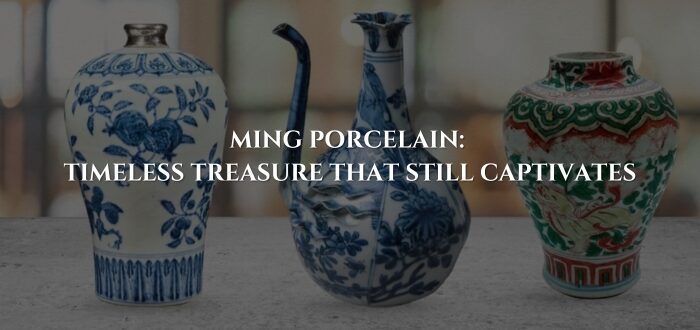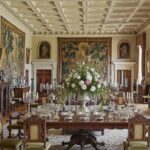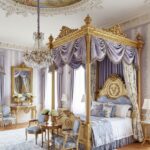Ming Dynasty Antiques: A Timeless Treasure
The world of antiques is vast and filled with treasures. Some of the iconic treasures like the Fabergé eggs or the Florentine diamond stand the test of time, gaining a legendary status. Collectors, even today, are fascinated by them and wish to add them to their collection. Among these most sought-after collections are the Ming dynasty antiques. Ming Dynasty vases, antique Ming bowls, and other Chinese porcelain creations continue to captivate collectors with their bold patterns, vibrant colours, and unmatched craftsmanship.

In this blog, we’ll explore the rich history of the Ming dynasty porcelain, trace its evolution, describe key types of Ming porcelain, and reveal what makes Ming antiques so extraordinary.
Also Read: Fabergé Eggs: World’s Most Opulent Gifts
A Golden Era of Culture and Commerce
The Ming Dynasty ruled China from 1368 to 1644 AD, overseeing one of the most prosperous and culturally rich periods in Chinese history. During this time, China’s population doubled, trade expanded rapidly, and the empire established deep cultural and diplomatic links with the West.
This was a time of flourishing literature, drama, philosophy, and above all, the rise of porcelain as an international luxury commodity.
This legacy of artistic excellence stretches back centuries, with Ming porcelain first arriving in Europe during the 17th century as prized possessions among royalty and the aristocracy.
Birth of the Porcelain Empire
By the 15th century, China was in the midst of an economic boom. The Ming Dynasty had brought stability and wealth, and with prosperity came a growing appetite for luxury goods. Chief among these was porcelain, which didn’t just dominate the market—it defined it.
It was during this period that the word “china” became globally synonymous with porcelain, a testament to the unmatched quality and artistry of Chinese ceramic production.
At the center of this porcelain revolution was Jingdezhen, a city in Jiangxi province that became the beating heart of imperial ceramic craftsmanship. Known as the “Porcelain Capital of the World.”
The Blue and White Masterpiece
If Ming porcelain had a signature hit, it would be the iconic blue-and-white ware. Using imported cobalt oxide, artisans painted dragons, florals, and calligraphic motifs onto white porcelain before glazing and firing. The result? Bold, rich designs that seemed to float under a glossy surface.
Beyond Blue: A Rainbow of Colours
While blue-and-white may have stolen the spotlight, Ming porcelain was never a one-trick wonder.
As the dynasty matured, artisans began to experiment with a broader colour palette. By the 15th and 16th centuries, kilns were producing vibrant pieces in red, yellow, green, purple, and overglaze enamels
Also Read: Discover the Allure of Meissen Porcelain
Types & Features of Ming Porcelain
Ming porcelain is celebrated not only for its technical brilliance but for the variety of forms, glazes, colours, and motifs. Here are the most iconic types and styles of Ming Dynasty porcelain:

- Ming Dynasty Vases
Ming vases are among the most recognized and coveted antiques in the world. Characterized by their graceful shapes, fine glaze work, and richly symbolic motifs, these vases often served both decorative and ceremonial purposes.
Many featured bold, swirling dragons, phoenixes, lotus blossoms, and peonies—symbols of power, purity, and renewal.
Some original Ming vases have fetched tens of millions at auction due to their rarity and pristine condition.
- Ming Dynasty Bowls: The Fish Bowl and Beyond
Among the various bowl forms, the Xuande-period fish pond bowl is legendary. These deep bowls depict koi and fangyu fish swimming among lotus plants and reeds, painted with exquisite naturalism.

Fish symbolized abundance, prosperity, and harmony, while the lotus added a spiritual dimension of purity and rebirth.
These bowls weren’t merely tableware—they were narrative pieces, rich in symbolism and often made for imperial use.
- Blue and White Porcelain
Perhaps the most iconic of all Ming porcelain styles, blue-and-white ware set the global benchmark for fine ceramics.
Export popularity surged during this time, making these wares highly sought-after in Europe, the Middle East, and Southeast Asia.
- Doucai Chicken Cups (Chenghua Period)
Few items in Chinese porcelain history are as revered as the Chenghua doucai “Chicken Cups.”
These small wine cups feature delicate images of a hen, rooster, and chicks amid garden flora.
Their subtle brushwork, soft colours, and refined doucai technique—using underglaze blue outlines with overglaze enamels—make them masterpieces of restraint and elegance.
A Chenghua chicken cup sold at auction for over $36 million, making it one of the most expensive ceramic pieces ever sold.
- Wucai (Five-Colour) Polychrome Porcelain
While blue and white dominated the early Ming period, the later Ming reigns embraced colourful polychrome styles.
Wucai, meaning “five colours,” used a mix of overglaze enamels—typically red, green, yellow, blue, and sometimes purple.
Scenes depicted included imperial court life, children at play, dragons in flight, and mythological tales.
- Shapes and Forms in Ming Porcelain
The diversity of Ming porcelain shapes speaks to both its artistic ambition and functional range.
Common forms:
Vases: meiping, baluster, pear-shaped, moon flasks
Bowls: fish bowls, tea bowls, wine cups
Plates: wide-rimmed or deep-dish
Flasks and Ewers: water droppers, pilgrim flasks, teapot-like vessels
Writing Tools: brush holders, inkstones, brush rests
Domestic and Decorative Items: incense burners, pillows, tiles, and bird feeders
- Decorative Motifs and Symbolism
Ming porcelain is deeply tied to Chinese symbolism, with motifs that carried layered meanings:

Common motifs included:
- Floral and botanical elements:
Lotus – purity and spiritual awakening
Peony – prosperity and honour
Chrysanthemum – longevity and resilience
- Scrollwork and Patterns:
Vine and Grape Scrolls – fertility and abundance
Reeds and Lotus Scrolls – tranquillity and rebirth
- Animals and Mythical Creatures:
Dragons – Imperial power
Phoenixes – peace and renewal
Carp (koi) – perseverance and success
Why Ming Porcelain Still Reigns Supreme
Centuries after its creation, Ming porcelain remains one of the most admired and collected art forms in the world. Here’s what makes it truly exceptional:
- Masterful Craftsmanship
Ming porcelain represents the pinnacle of ceramic skill. Produced primarily in Jingdezhen, artisans perfected high-temperature firing techniques, delicate brushwork, and flawless glazing methods.
- Iconic Design
From the elegant curves of meiping vases to the delicately proportioned chicken cups, Ming pieces are instantly recognizable.
- Bold and Lasting Colours
Ming artisans pioneered the use of imported cobalt to achieve vivid, rich blues that remain vibrant centuries later. Later innovations introduced polychrome enamels in brilliant reds, greens, yellows, and purples.
- Rich Symbolism and Motifs
Decorative elements weren’t just aesthetic—they told stories and conveyed meaning. These motifs made each piece not just a visual delight but a cultural narrative in ceramic form.
- Imperial Patronage
Much of the finest Ming porcelain was commissioned by the imperial court, produced under strict standards in government-run kilns.
The Hunt for Ming Porcelain Continues
Centuries after the last Ming emperor fell, the hunt for Ming porcelain is far from over. Collectors, curators, and historians across the globe continue to seek out these rare treasures—whether in museum archives, private collections, or the occasional surprise discovery at auctions and estate sales.
Their value goes beyond monetary worth. Each piece carries a story—of imperial power, global trade, artistic mastery, and cultural symbolism.
The Legacy Lives On
The legacy of Ming Dynasty porcelain endures—not just in museums, but in the aesthetics of modern ceramics, the techniques passed down through generations, and the deep admiration it commands worldwide.
Whether admired from behind glass or displayed in the heart of a home, Ming porcelain remains one of history’s most iconic artistic legacies—one that continues to inspire and captivate with every curve, colour, and brushstroke.






